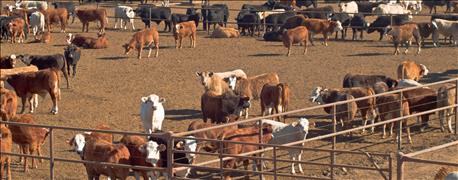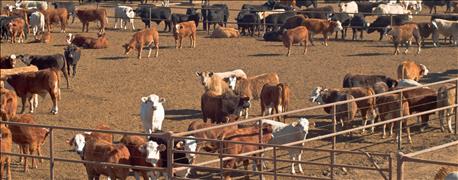November 4, 2016

There is a lot of talk about what’s behind the collapse in beef prices. Feeder cattle prices are still down over 45% from two years ago, even though prices in grocery stores remain largely unchanged.
R-CALF United Stockgrowers (the Ranchers-Cattlemen Action Legal Fund) says there is an antitrust conspiracy at work. It is planning to hold a series of meetings across the Dakotas.
A Montana State University professor says it’s just market forces, and cattle producers benefited from the forces in 2014 when feeder cattle prices rose dramatically.
Here is more about the two views:

WORTH LESS: Feeder cattle prices are down 45%, sparking calls for an antitrust investigation. But ordinary market forces might be at work.
Antitrust conspiracy
In a January 2016 letter to members of the U.S. Senate Judiciary Committee requesting an antitrust investigation, R-CALF USA wrote:
“Industry analysts cannot explain the wholesale collapse of the cash market or the intense volatility and collapse in the cattle futures market. Describing the collapse and volatility with vague terms such as ‘market meltdown’ or ‘psychological upheaval,’ analysts appear unwilling to state the obvious: that something caused a severe anomaly in U.S. cattle markets that caused significant harm to U.S. cattle producers and U.S. consumers.
“As cattle prices plummeted, meatpackers were making what one analyst called ‘gangbuster profits’ and consumer beef prices remained at or near record highs.
“Not surprisingly, meatpacker-aligned commentators pointed fingers at cattle feeders, accusing them of causing the price collapse by feeding their cattle too long. But this is nonsense as only a small percentage of cattle are not directly controlled by meatpackers, and some of the remaining independent cattle feeders reported that meatpackers were purposely delaying cattle delivery dates.
“… R-CALF USA believes the 2015 cattle market succumbed to antitrust and anticompetitive conduct by dominant meatpackers and perhaps by certain traders in the cattle futures market. We respectfully request an investigation to determine, among other things, the cause for the dramatic, unprecedented collapse of U.S. cattle prices in 2015; whether there are structural problems in the U.S. cattle market that contributed to the market collapse in 2015; and, whether dominant meatpackers or other major market participants engaged in unlawful conduct that adversely influenced the cattle futures market and the cash cattle market in 2015.”
R-CALF USA contends that “one or more participants within the beef supply chain, who are sandwiched between the cattle producer and the beef consumer,” siphoned away approximately 13% of the value of retail beef that competitive market forces were previously allocating to U.S. cattle producers ... “In other words, evidence shows that other participants within the beef supply chain are capturing a significant share of the consumers’ beef dollar that a competitive market should be allocating, and previously did allocate, to the producer.”
This, R-CALF USA believes, is strong evidence of antitrust and anticompetitive conduct by the nation’s four largest meatpackers, which are the supply chain participants that are purchasing the vast majority of live cattle directly from U.S. cattle producers (the four largest packers control approximately 85% of the fed cattle slaughtered).
Market forces
“Economics research has repeatedly shown, however, that there is little evidence that specifically anti-competitive behavior in the meatpacking industry substantially impacts feeder cattle market prices, especially in the short run. Instead, the issue is much more about market fundamentals,” says Anton Bekkerman, an associate professor in the Department of Agricultural Economics and Economics at Montana State University.
The issue, he says, was an oversupply of feeder cattle and the fact that stockgrowers couldn’t adjust their herd quickly in response to changes in the market.
“This implies that feeder cattle producers have little leverage and are more likely to take on a larger incidence of market price reductions (i.e., they have fewer opportunities to not sell their cattle when market prices are low and, as a result, have to accept what the market gives them). For this reason, another study found that for every 1% decrease in the price of beef at the retail level, feeder cattle prices decrease, on average, 1.30%,” he says.
Packers, on the other hand, have more flexibility in managing slaughter quantities and inventories, and are thus able to use this additional leverage to pass on the costs to feeder cattle producers.
“Markets observe similar conditions (albeit in reverse) when the demand for beef products increases,” he says.
This was the case in 2014 and 2015 when the 2015 avian influenza may have led some consumers to buy more beef. Processors and packers responded by increasing their production and, in turn, increasing market demand for feeder cattle. Because this demand occurred during a period when herd sizes were already relatively small after significant cattle culling in response to the 2012-14 droughts, and the biological constraints of cattle production limit the speed with which new cattle can be produced to meet the demand, it was the feeder cattle market that most benefited in the form of historically high prices, while the fed cattle and packers were left with lower profit margins, Bekkerman says.
“In both cases — expansion or contraction of production — processing and packing facilities are not necessarily doing anything that is anti-competitive or illegal, but simply acting efficiently in the marketing landscape they face. Market fundamentals and the nature of cattle production are, thus, likely to blame.”
You May Also Like




